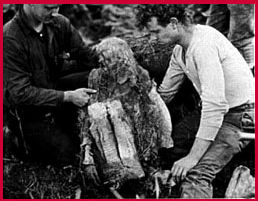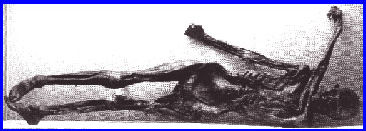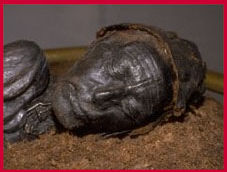 |
 |
 |
 Mummies of the World
Mummies of the WorldPart 3 (back to Part 2) Other embalming methods Embalming methods usually reflect the tools and materials available. For example, the Aleut people, who lived on the Aleutian Islands off the coast of Alaska, mummified their dead by removing the organs and stuffing the cavity with dry grass. Next they laid the body in a stream, where the running water dissolved the fat and washed it away, leaving only muscle and skin. The body was then tied in a squatting position and dried in the open air. Once it was dry, the mummy was wrapped in several layers of waterproof leather and woven clothing and placed in a warm cave, either hanging from the ceiling or lying on a platform to keep it off the damp floor. In one Aleutian cave, archaeologists found more than 50 mummies dating back 250 years. In Papua New Guinea, embalmers smoke-cured the dead, covered them in a protective layer of clay and propped them up on scaffolding that overlooked their villages. It's not known exactly how the Anasazi, who lived in the "four corners" region of the American Southwest, mummified their dead. But mummies dating as far back as 100 A.D have been found wrapped in fur and leather blankets in caves and rock holes—often wearing a new pair of sandals, presumably for use in the next life.  Accidental mummies
Accidental mummiesSome of the most spectacular mummies were created accidentally. In 1991, German climbers found a body frozen on top of a glacier near the Austrian-Italian border. Initially, the police and forensic experts who arrived on the scene didn't realize how old the body was—even though he was wearing a grass cape, carrying a bow and arrows and had shoes stuffed with grass for warmth. Later, radiocarbon dating determined that the "Iceman" died sometime between 3350 and 3300 B.C.—making him the oldest well-preserved mummy in the world. In 1972, hunters found some of the best ever naturally-preserved human bodies at a remarkable abandoned settlement called Qilakitsoq, in Greenland. The "Greenland Mummies," who died about 500 years ago, consisted of a six-month old baby, a four year old boy, and six women of various ages. Protected by a rock that overhung a shallow cave, the bodies were naturally mummified by the sub-zero temperatures and dry, dehydrating winds. Accompanying the eight bodies were seventy-eight items of clothing, most made out of seal skin.  Over the years, peat cutters working the bogs of northwest Europe have
uncovered hundreds of mummies. The spongy top layer of a peat bog tends to
seal off oxygen from the layers below. A bog's naturally acidic environment
also helps to create mummies and gives them a distinctively brown, leathery and
life-like appearance. The oldest "bog mummies" are from the Iron Age (between
400 B.C. and 400 A.D.) and were Celtic or Germanic contemporaries of the
Romans. Strangely, many of the mummies found in the European bogs show
evidence of violent deaths. With slit throats and broken skulls, these
individuals may have been victims of ritual sacrifice, not unlike the mummies
of the high Andes.
Over the years, peat cutters working the bogs of northwest Europe have
uncovered hundreds of mummies. The spongy top layer of a peat bog tends to
seal off oxygen from the layers below. A bog's naturally acidic environment
also helps to create mummies and gives them a distinctively brown, leathery and
life-like appearance. The oldest "bog mummies" are from the Iron Age (between
400 B.C. and 400 A.D.) and were Celtic or Germanic contemporaries of the
Romans. Strangely, many of the mummies found in the European bogs show
evidence of violent deaths. With slit throats and broken skulls, these
individuals may have been victims of ritual sacrifice, not unlike the mummies
of the high Andes.Mummies of the World | The High Mummies | Preserving a Mummy | Sarita's Land Photos: (1) courtesy Harold McCracken; (2) Courtesy University of Insbruck; (3) Courtesy Silkeborg Museum. Expedition '96 | Dispatches | Mummies | Lost Worlds | Mail Resources | Site Map | Ice Mummies of the Inca Home | BBC Horizon Editor's Picks | Previous Sites | Join Us/E-mail | TV/Web Schedule About NOVA | Teachers | Site Map | Shop | Jobs | Search | To print PBS Online | NOVA Online | WGBH © | Updated November 2000 |